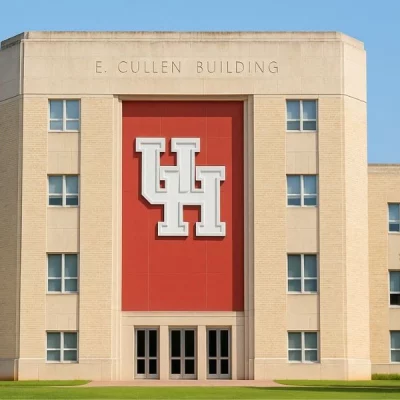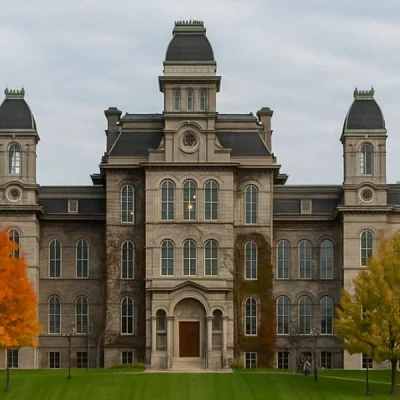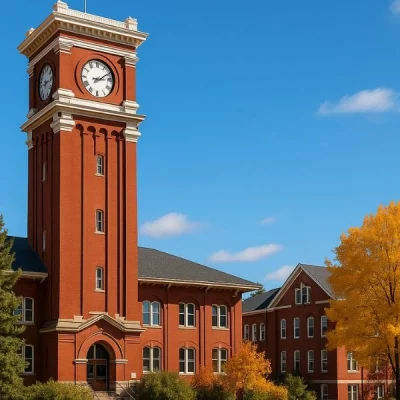Pennsylvania State University: Guide to Acceptance Rate, Admissions, Scholarship
Table of Contents
Pennsylvania State University is commonly known as Penn State, a public research institution with campuses and facilities across the state. You will find a list of campuses spread across the state, browse through the blog and find one that you desire.
Since the 1930’s the university has awarded more than half-million students and continues the mission to provide exceptional education. The Governor and other representatives of the Commonwealth have held seats on Penn State’s Board of Trustees since the institution’s inception, and the legislature has made regular appropriations supporting the University’s mission since 1887.
Today, it is one of the most sought-after universities in the world among students who seek to pursue higher education. As of 2022, there’s a total enrollment of over 88,116 students with 11, 000 being international students.
| QS World University Rankings | Acceptance Rate | Tuition Fee | QS Stars |
| #83 | 52.2% | $11,560 onwards | 5 |
Why study at Penn State University?
- Hold a global ranking
- Top 15 institutions hosting international students
- Provides academic mobility
- Excel in research and academics
- Divers and inclusiveness
- Close-knit community students
- Resources and opportunities
- Internship and job opportunities
- Affordable Student Accommodation Pennsylvania
Timeline: History of Pennsylvania State University
1749-1801 – Penn’s First Campus.
1953 – Received its official university name, The Pennsylvania State University.
Late 19th – 20th century – expands curriculum beyond agriculture to arts, engineering and other disciplines.
1855 – started as an agriculture college.
1859 – admitted first class.
1963 – designated as the Commonwealth’s sole land-grant institution by the state’s legislature.
1874 – Change to Pennsylvania State College.
1980s – became an important research center in the field of materials science, engineering, and agriculture.
1900s – 2000 – Expanded its academic programs, research initiatives and campuses across Pennsylvania.
Present Day – Today, it is one of the best and most renowned universities in the US offering programs in Bachelor, Master and Professional in various disciplines across the campus of the university.
Penn State University Campus
The University Park campus is the best for Penn State University. The other university campus is in:
- University Park (Main Campus) – Located in State College, Pennsylvania.
- Abington – Located in Abington Township, Pennsylvania.
- Altoona – in Altoona, Pennsylvania.
- Beaver – Located in Monaca, Pennsylvania.
- Behrend – Located in Erie, Pennsylvania.
- Berks – Located in Spring Township, Pennsylvania.
- Brandywine – in Middletown Township, Pennsylvania.
- DuBois – Located in DuBois, Pennsylvania.
- Fayette – Located in Uniontown, Pennsylvania.
- Greater Allegheny – Located in McKeesport, Pennsylvania.
- Harrisburg – Located in Middletown, Pennsylvania.
- Hazleton – Located in Hazleton, Pennsylvania.
- Lehigh Valley – Located in Center Valley, Pennsylvania.
- Mont Alto – Located in Mont Alto, Pennsylvania.
- New Kensington – Located in Upper Burrell Township, Pennsylvania.
- Schuylkill – Located in Schuylkill Haven, Pennsylvania.
- Scranton – Located in Dunmore, Pennsylvania.
- Shenango – Located in Sharon, Pennsylvania.
- University College – Located in Philadelphia, Pennsylvania (Offers online courses and programs).
- Wilkes-Barre – Located in Lehman Township, Pennsylvania.
- World Campus – Penn State’s online campus, accessible from anywhere with an internet connection.
Understanding Acceptance Rates of Penn State University
Based on the acceptance rate of any institution, that’s how you know the competitive rate and admission process is easy or difficult to score a seat at the university.
As mentioned above in the table, the acceptance rate is 55.2% out of which 100 applicants, only 55 are admitted to the university.
The competition to get into this institution is moderate, and if you want to get admission into the university, you will have to meet your GPA. SAT and ACT requirements.
How is the acceptance rate of Penn State University calculated?
Penn State acceptance rate = number of students accepted/ number of applicants.
There are no such things as bad or good acceptance rates, but it’s important for the university and the student.
Acceptance rates are important for students to weigh their chances of success. And, for institutions, it is a critical factor to select students on a fair basis based on the factors laid down by the universities.
Penn State Acceptance Rate Overview
For class 2027 – 128,000 applicants where 16,000 got enrolled into the institution for their higher education.
For class 2023 – 15,735 applicants where 1,189 were granted admission into the institution making Penn State Park University’s acceptance rate at 7.5%.
Penn State trends in acceptance rates
| Batch | No. Of Applicants | No. Of Students Admitted | Acceptance Rate |
| 2026 | 78,578 | 45,269 | 57.6% |
| 2025 | 73,861 | 40,031 | 54.2% |
| 2024 | 71,903 | 35,302 | 49.1% |
Factors Influencing Penn State Acceptance Rate
The various factors that influence Penn State’s acceptance rate and make Penn State competitive are:
Academic Criteria (GPA, standardized test scores)
This is one of the most crucial factors that plays an important factor that influences the acceptance rate. While most universities vary in terms of GPA, SAT or ACT, there’s a minimum Penn State GPA requirement, Penn State SAT/ACT scores you need to fulfil to gain admissions.
Bachelor:
- SAT – 1330+
- GPA – 3.55+
Masters:
- GMAT – 560+
- GRE – 303+
- GPA – 3+
Class Rank
This is another important factor influencing the acceptance rate of the university. It’s a simple rule, the higher you score, the bigger your chances of getting admission into the university.
Extracurricular activities
While applying to the university, consider mentioning your Penn State extracurricular activities as colleges seek an all-rounded student who is involved in extracurricular activities be it sports, volunteering or any other activities. It shows your skills in handling multiple responsibilities.
Demographics of applicants
Just like any other institution, Penn State University is all about inclusiveness and wants to have a diverse student body. The demographic factors will be based on race, ethnicity and socio-economic status.
Financial aid
Even Penn State University prioritizes students who need financial aid. This means it is more likely that students will be given scholarships. It makes the institution more affordable to attend.
Letters of recommendation
While this may not look like something important, it’s another crucial factor to influence your acceptance rate. As a professor or a manager, you can jot down good things about your character, work ethic and potential for success in college.
Admissions Requirements for Penn State University
For Penn State admissions Penn State application process, you need to full fill while applying to the university:
- Bachelor’s Degree from a reputed and accredited institution.
- Official educational documents which include the secondary and post-secondary school records.
- Proof of standardized test scores (SAT/ACT/GMAT).
- Proof of English language proficiency (IELTS: 6.5 | TOEFL: 80).
- Letters of recommendation (LORs).
- Resume/CV.
- Completed and submit online application.
Penn State tips for applicants:
Getting into Penn State University Park is competitive; thus, you need to submit an exceptional grade; showcase your extra-curricular activities, strong LORs, outstanding essays/personal statements, etc.
We suggest applying early for higher chances of review and acceptance into the university.
Scholarship opportunities at Penn State University
Check out these scholarships below and find one that is suitable for you to apply for financial aid. Get in touch with the university for more details on the same:
Merit-Based Scholarship: This is based on the academic GPA and SAT/ ACT score. The two most famous among them are the President’s Freshman Award, Provost Award, and Trustee Scholarship.
Need Base Scholarship: This is given to students who can demonstrate the need for financial aid. The scholarship will cover the tuition fees and other educational expenses.
Special Scholarship: This is for talented students who can excel in the field of research and discovery. There are many scholarships available for students in various categories.
Diversity Scholarship: This is a scholarship for students coming from a minority or different cultural background.
International Student Scholarship: This is a specific scholarship for international students to help with studying costs.
Conclusion
The thumb rule to apply to Penn State University is to consider looking into the acceptance rate, the factors influencing it and make an early application.
The significance of the Penn State acceptance rate for prospective students is on a high level.
To get more detailed information on the acceptance rate, admission process, application dates, check out the Penn State’s admissions information and resources on their official website: https://www.psu.edu/







